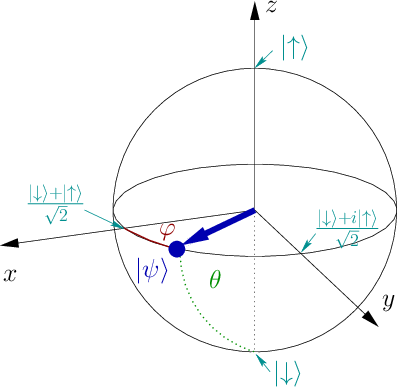Quantum noise in atomic clocks
Bloch-Sphere Gymnastics
In contrast to classical 2-state systems (like bits) a quantum system can be in an arbitrary superposition of both states.
The quantum state can be parametrized by the two angles θ∈{0 ∘ …180 ∘ } and φ∈{0 ∘ …360 ∘ } :
|ψ(θ,φ)⟩=cos(θ/2)|↓⟩+sin(θ/2)e iφ |↑⟩
Therefore each quantum state of this 2-level system can be represented by a point on a sphere with radius 1:

- The |↓⟩ and |↑⟩ states form the south- and north pole.
- Equal superpositions of |↓⟩ and |↑⟩ (with θ=90 ∘ ) lie on the equator.
- When measuring a system in quantum state |ψ(θ,φ)⟩ the probability to find it the ↓ -state is p(↓)=cos 2 (θ/2) ; The probability to find it in the ↑ -state is p(↑)=sin 2 (θ/2) .
- If our reference oscillator is detuned from the atomic resonance by a frequency Δν=ν clock −ν osc the phase φ evolves like φ(t)=2πΔν as the state vector slowly rotates around the z -axis.
We use resonant microwave pulses to change the state of our quantum system. The effect of a microwave pulse can be understood as a rotation of the Bloch sphere around an axis that lies in the equatorial plane.
The orientation of that axis can be determined by the phase of the microwave pulse and the rotation angle by the pulse duration.
